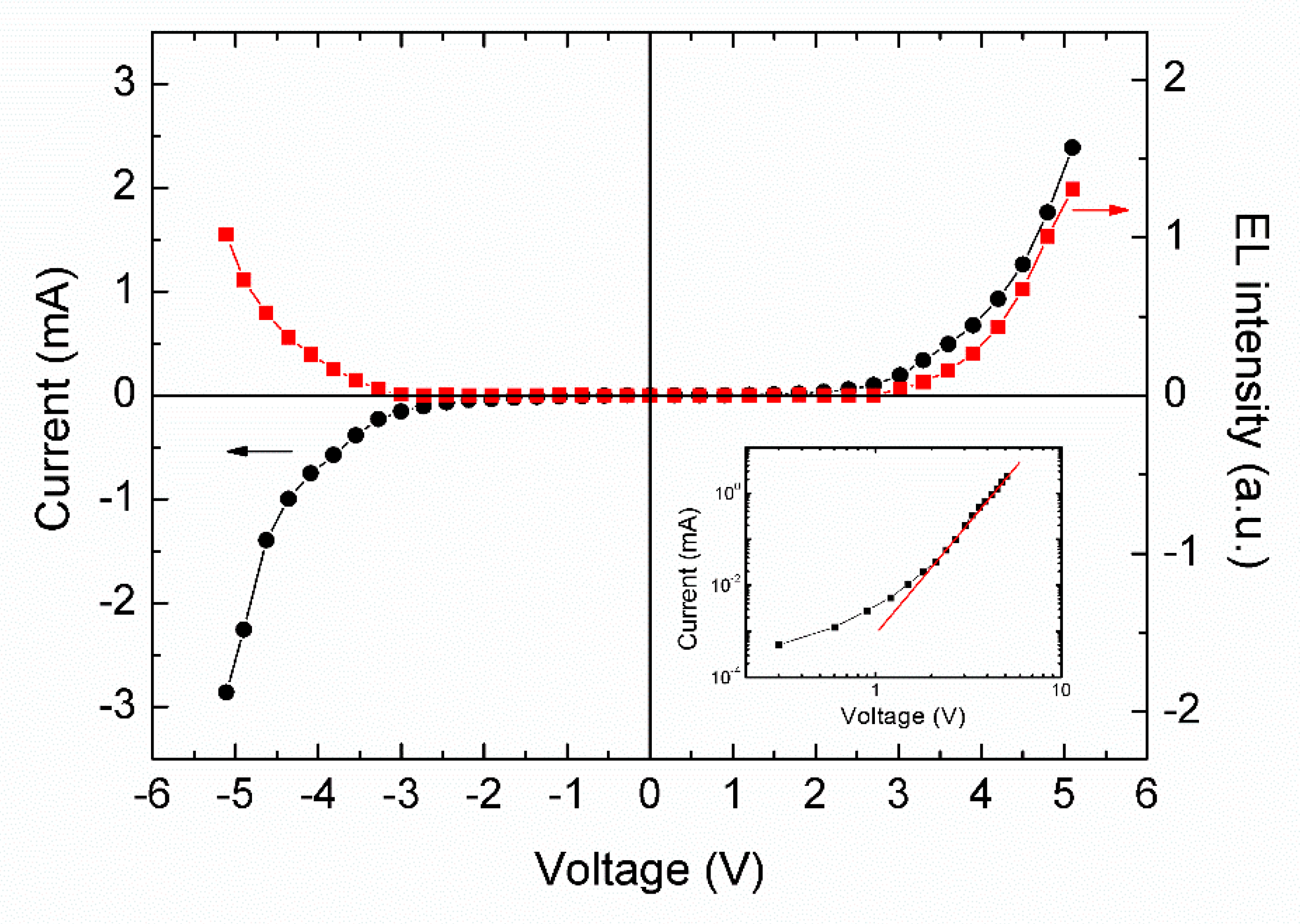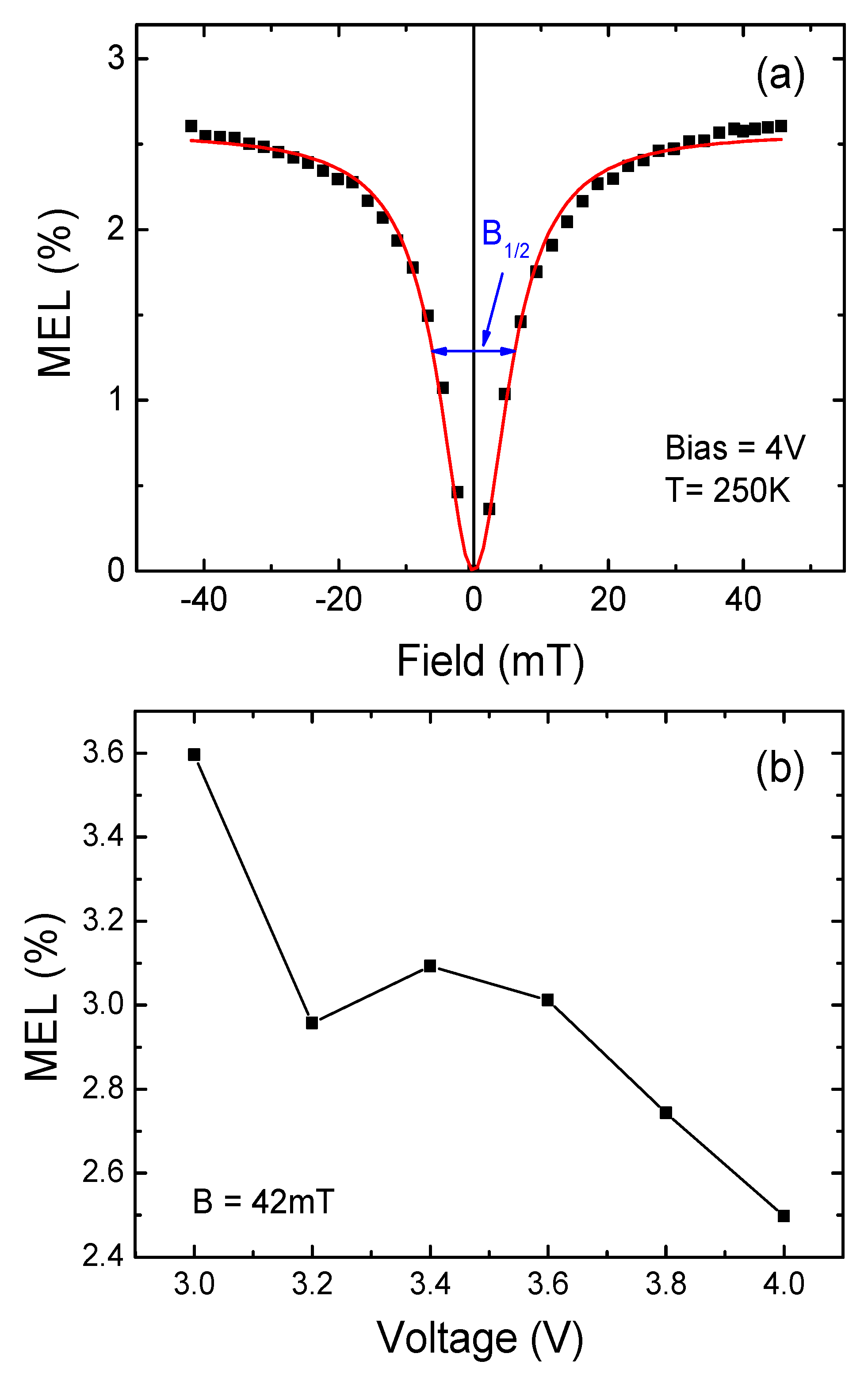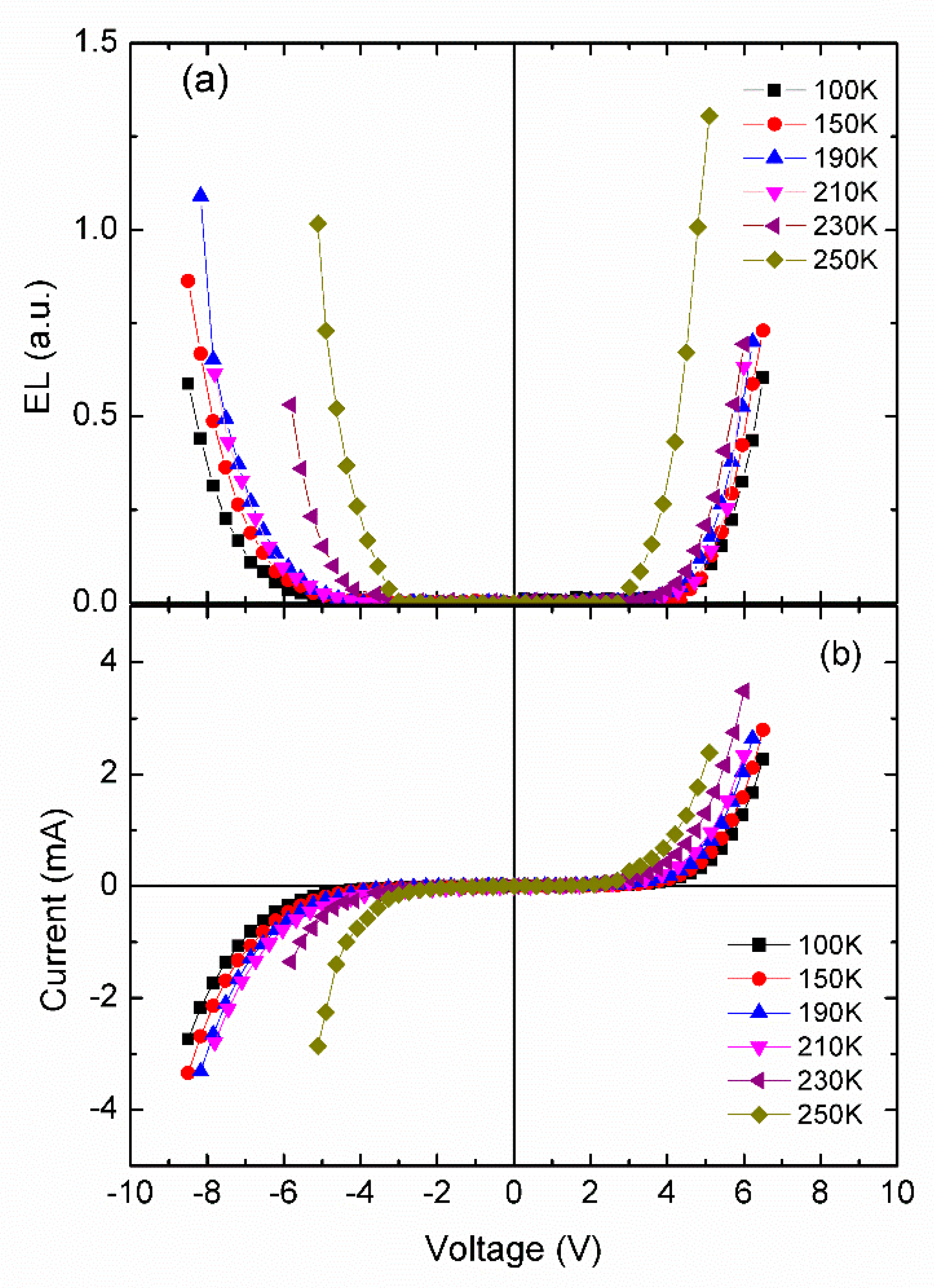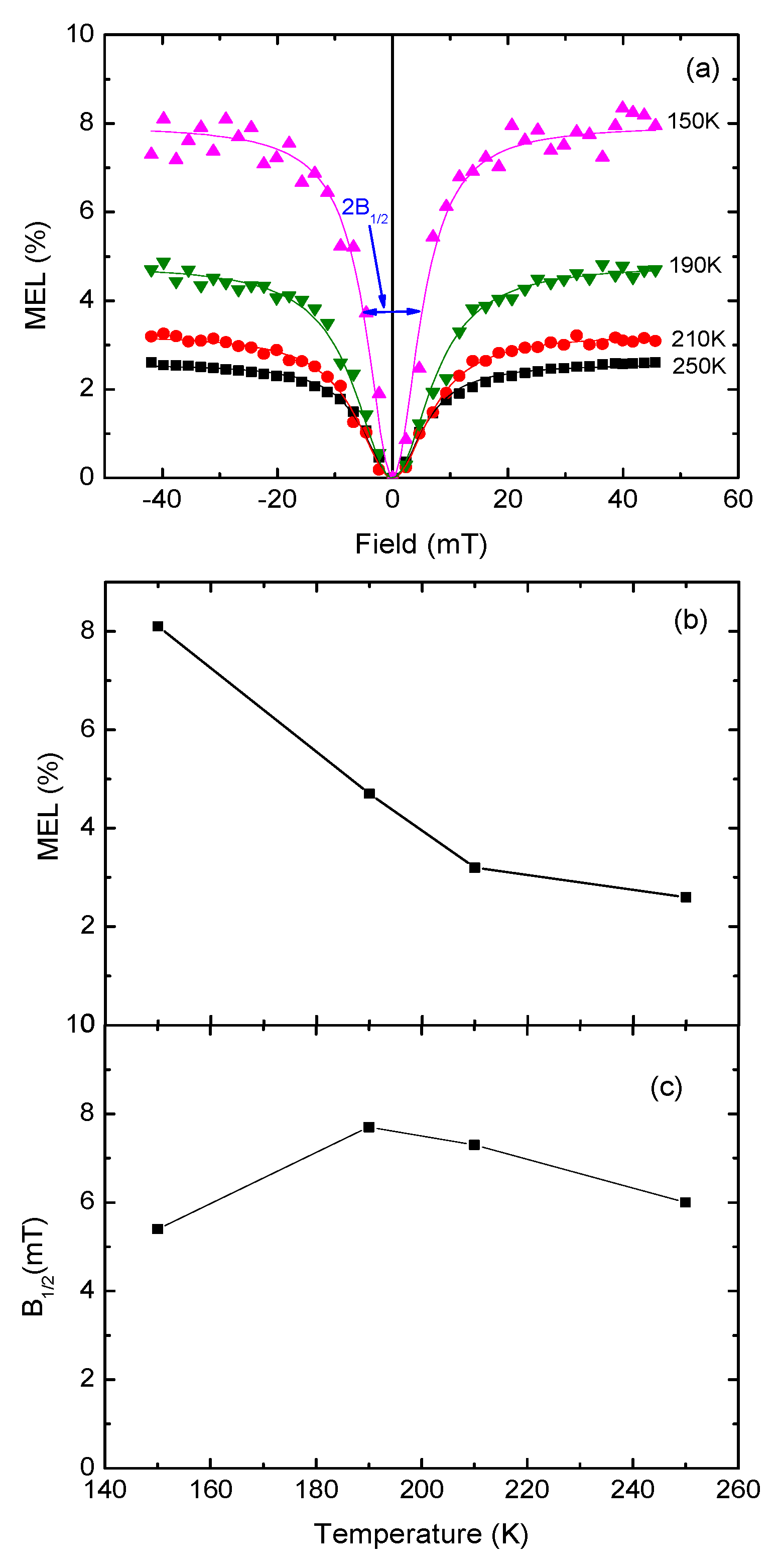Magneto-Electroluminescence in ITO/MEH-PPV:PEO:LiCF3SO3/Al Polymer Light-Emitting Electrochemical Cells
Abstract
1. Introduction
2. Materials and Methods
3. Results and Discussion
4. Conclusions
Author Contributions
Funding
Conflicts of Interest
References
- Kalinowski, J.; Cocchi, M.; Virgili, D.; Marco, P.D.; Fattori, V. Magnetic field effects on emission and cur-rent in Alq3-based electroluminescent diodes. Chem. Phys. Lett. 2003, 380, 710–715. [Google Scholar] [CrossRef]
- Geng, R.G.; Daugherty, T.T.; Do, K.; Luong, H.M.; Nguyen, T.D. A review on organic spintronic materials and devices: I. Magnetic field effect on organic light emitting diodes. J. Sci. Adv. Mater. Dev. 2016, 1, 128–140. [Google Scholar] [CrossRef]
- Xu, H.X.; Wang, M.S.; Yu, Z.G.; Wang, K.; Hu, B. Magnetic field effects on excited states, charge transport, and electrical polarization in organic semiconductors in spin and orbital regimes. Adv. Phys. 2019, 68, 9–121. [Google Scholar] [CrossRef]
- Pang, Z.Y.; Sun, D.L.; Zhang, C.; Baniya, S.; Kwon, O.; Vardeny, Z.V. Manipulation of Emission Colors Based on Intrinsic and Extrinsic Magneto-Electroluminescence from Exciplex Organic Light-Emitting Diodes. ACS Photon. 2017, 4, 1899–1905. [Google Scholar] [CrossRef]
- Janssen, P.; Wouters, S.; Cox, M.; Koopmans, B. Unraveling the temperature and voltage dependence of magnetic field effects in organic semiconductors. J. Appl. Phys. 2013, 114, 174909. [Google Scholar] [CrossRef]
- Lei, Y.L.; Zhang, Y.; Liu, R.; Chen, P.; Song, Q.L.; Xiong, Z.H. Driving current and temperature dependent magnetic-field modulated electroluminescence in Alq3-based organic light emitting diode. Org. Electron. 2009, 10, 889–894. [Google Scholar] [CrossRef]
- Basel, T.; Sun, D.L.; Baniya, S.; McLaughlin, R.; Choi, H.; Kwon, O.; Vardeny, Z.V. Magnetic Field Enhancement of Organic Light-Emitting Diodes Based on Electron Donor–Acceptor Exciplex. Adv. Electron. Mater. 2016, 2, 1500248. [Google Scholar] [CrossRef]
- Jia, W.Y.; Ikoma, T.; Chen, L.X.; Zhu, H.Q.; Tang, X.T.; Qu, F.L.; Xiong, Z.H. Using magneto-electroluminescence as a fingerprint to identify the spin polarization and spin-orbit coupling of magnetic nanoparticle doped polymer light emitting diodes. RSC Adv. 2019, 9, 15845–15851. [Google Scholar]
- Desai, P.; Shakya, P.; Kreouzis, T.; Gillin, W.P.; Morley, N.A.; Gibbs, M.R.J. Magnetoresistance and efficiency measurements of Alq3-based OLEDs. Phys. Rev. B. 2007, 75, 094423. [Google Scholar] [CrossRef]
- Bobbert, P.A.; Nguyen, T.D.; Oost, F.W.A.; Koopmans, B.; Wohlgenannt, M. Bipolaron mechanism for organic magnetoresistance. Phys. Rev. Lett. 2007, 99, 216801. [Google Scholar] [CrossRef]
- Chitraningrum, N.; Chu, T.Y.; Huang, P.T.; Wen, T.C.; Guo, T.F. The triplet-triplet annihilation process of triplet to singlet excitons to fluorescence in polymer light-emitting diodes. Org. Electron. 2018, 62, 505–510. [Google Scholar] [CrossRef]
- Pei, Q.B.; Yu, G.; Zhang, C.; Yang, Y.; Heeger, A.J. Polymer Light-Emitting Electrochemical Cells. Science 1995, 269, 1086–1088. [Google Scholar] [CrossRef]
- Pei, Q.B.; Yang, Y.; Yu, G.; Zhang, C.; Heeger, A.J. Polymer Light-Emitting Electrochemical Cells: In Situ Formation of a Light-Emitting p-n Junction. J. Am. Chem. Soc. 1996, 118, 3922–3929. [Google Scholar] [CrossRef]
- Gao, J. Polymer light-emitting electrochemical cells-Recent advances and future trends. Curr. Opin. Elctrochem. 2018, 7, 87–94. [Google Scholar] [CrossRef]
- Ni, G.; Nguyen, T.D.; Vardeny, Z.V. Study of magneto-electroluminescence and magneto-conductance in polymer light-emitting electrochemical cells. Appl. Phys. Lett. 2011, 98, 263302. [Google Scholar] [CrossRef]
- Reenen, S.; Kersten, S.P.; Wouters, S.H.W.; Cox, M.; Janssen, P.; Koopmans, B.; Bobbert, P.A.; Kemerink, M. Large magnetic field effects in electrochemically doped organic light-emitting diodes. Phys. Rev. B 2013, 88, 125203. [Google Scholar] [CrossRef]
- Geng, R.; Mayhew, N.T.; Nguyen, T.D. Tunable magneto-conductance and magneto-electroluminescence in polymer light-emitting electrochemical planar devices. Appl. Phys. Lett. 2013, 103, 243307. [Google Scholar] [CrossRef]
- Linford, R.G. Electrochemical Science and Technology of Polymers; Springer: Berlin, Germany, 1987. [Google Scholar]
- Wagberg, T.; Hania, P.R.; Robinson, N.D.; Shin, J.H.; Matyba, P.; Edman, L. On the limited operational lifetime of light-emitting electrochemical cells. Adv. Mater. 2008, 20, 1744–1749. [Google Scholar] [CrossRef]
- Pei, Q.; Yang, Y.; Yu, G.; Cao, Y.; Heeger, A.J. Solid state polymer light-emitting electrochemical cells: Recent developments. Synth. Met. 1997, 85, 1229–1232. [Google Scholar] [CrossRef]
- Shin, J.H.; Robinson, N.D.; Xiao, S.; Edman, L. Polymer light-emitting electrochemical cells: doping concentration, emission-zone position, and turn-on time. Adv. Funct. Mater. 2007, 17, 1807–1813. [Google Scholar] [CrossRef]
- Burrows, P.E.; Shen, Z.; Bulovic, V.; McCarty, D.M.; Forrest, S.R.; Cronin, J.A.; Thompson, M.E. Relationship between electroluminescence and current transport in organic heterojunction light-emitting devices. J. Appl. Phys. 1996, 79, 7991–8006. [Google Scholar] [CrossRef]
- Mermer, O.; Veeraraghavan, G.; Francis, T.L.; Sheng, Y.; Nguyen, D.T.; Wohlgenannt, M.; Kohler, A.; Al-Suti, M.K.; Khan, M.S. Large magnetoresistance in nonmagnetic π-conjugated semiconductor thin film devices. Phys. Rev. B 2005, 7272, 205202. [Google Scholar] [CrossRef]
- Sheng, Y.; Nguyen, T.D.; Veeraraghavan, G.; Mermer, Ö.; Wohlgenannt, M.; Qiu, S.; Scherf, U. Hyperfine interaction and magnetoresistance in organic semiconductors. Phys. Rev. B 2006, 74, 045213. [Google Scholar] [CrossRef]
- Nguyen, T.D.; Hukic-Markosian, G.; Wang, F.J.; Wojcik, L.; Li, X.G.; Ehrenfreund, E.; Vardeny, Z.V. Isotope effect in spin response of π-conjugated polymer films and devices. Nat. Mater. 2010, 9, 345–352. [Google Scholar] [CrossRef]
- Pan, H.P.; Shen, Y.; Luan, L.; Lu, K.; Duan, J.S.; Hu, B. Changing the sign of exchange interaction in radical pairs to tune magnetic field effect on electrogenerated chemiluminescence. J. Phys. Chem. C 2015, 119, 8089–8094. [Google Scholar] [CrossRef]
- Pan, H.P.; Shen, Y.; Duan, J.S.; Lu, K.; Hu, B. Spin-dependent deprotonation induced giant magnetocurrent in electrochemical cells. Phys. Chem. Chem. Phys. 2016, 18, 9897–9901. [Google Scholar] [CrossRef]
- Bagnich, S.A.; Niedermeier, U.; Melzer, C.; Sarfert, W.; Seggern, H. Origin of magnetic field effect enhancement by electrical stress in organic light emitting diodes. J. Appl. Phys. 2009, 106, 113702. [Google Scholar] [CrossRef]
- Zhang, S.J.; Drew, A.J.; Kreouzis, T.; Gillin, W.P. Modelling of organic magnetoresistance as a function of temperature using the triplet polaron interaction. Synth. Met. 2011, 161, 628–631. [Google Scholar] [CrossRef]





© 2019 by the authors. Licensee MDPI, Basel, Switzerland. This article is an open access article distributed under the terms and conditions of the Creative Commons Attribution (CC BY) license (http://creativecommons.org/licenses/by/4.0/).
Share and Cite
Zhu, M.; Yuan, X.; Ni, G. Magneto-Electroluminescence in ITO/MEH-PPV:PEO:LiCF3SO3/Al Polymer Light-Emitting Electrochemical Cells. Micromachines 2019, 10, 546. https://doi.org/10.3390/mi10080546
Zhu M, Yuan X, Ni G. Magneto-Electroluminescence in ITO/MEH-PPV:PEO:LiCF3SO3/Al Polymer Light-Emitting Electrochemical Cells. Micromachines. 2019; 10(8):546. https://doi.org/10.3390/mi10080546
Chicago/Turabian StyleZhu, Mingpeng, Xueting Yuan, and Gang Ni. 2019. "Magneto-Electroluminescence in ITO/MEH-PPV:PEO:LiCF3SO3/Al Polymer Light-Emitting Electrochemical Cells" Micromachines 10, no. 8: 546. https://doi.org/10.3390/mi10080546
APA StyleZhu, M., Yuan, X., & Ni, G. (2019). Magneto-Electroluminescence in ITO/MEH-PPV:PEO:LiCF3SO3/Al Polymer Light-Emitting Electrochemical Cells. Micromachines, 10(8), 546. https://doi.org/10.3390/mi10080546




